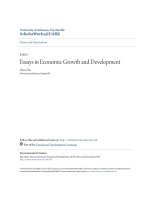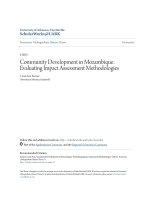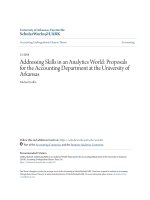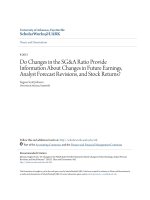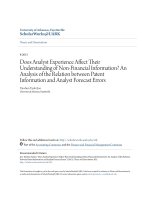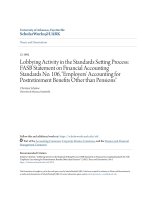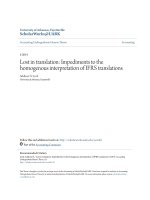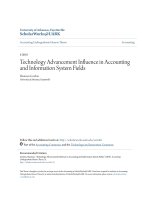Accounting undergraduate Honors theses: Essays in development economics and economics of the family
Bạn đang xem bản rút gọn của tài liệu. Xem và tải ngay bản đầy đủ của tài liệu tại đây (1.33 MB, 153 trang )
University of Arkansas, Fayetteville
ScholarWorks@UARK
Theses and Dissertations
12-2012
Essays in Development Economics and Economics
of the Family
Aaron Johnson
University of Arkansas, Fayetteville
Follow this and additional works at: />Part of the Finance Commons, and the Growth and Development Commons
Recommended Citation
Johnson, Aaron, "Essays in Development Economics and Economics of the Family" (2012). Theses and Dissertations. 570.
/>
This Dissertation is brought to you for free and open access by ScholarWorks@UARK. It has been accepted for inclusion in Theses and Dissertations by
an authorized administrator of ScholarWorks@UARK. For more information, please contact ,
ESSAYS IN DEVELOPMENT ECONOMICS
AND ECONOMICS OF THE FAMILY
ESSAYS IN DEVELOPMENT ECONOMICS
AND ECONOMICS OF THE FAMILY
A dissertation submitted in partial fulfillment
of the requirements for the degree of
Doctor of Philosophy in Economics
By
Aaron Lee Johnson
University of Nebraska
Bachelor of Arts in Business Administration, 2002
University of Arkansas
Master of Arts in Economics, 2009
December 2012
University of Arkansas
ABSTRACT
Chapter 1 explores a potential solution to the continuing disequlibrium in microfinance markets.
I design a mechanism to aid in securitization of microloans, using a dynamic investment pool
governed by a Central Microcredit Clearinghouse (CMC), that would sell investment units back
to MFIs and outside investors simultaneously. The CMC would serve as a catalyst to this other
avenue of microcredit financing, securitization of microloans, which could help spawn the type
of growth in investor-based funding of MFIs that is so urgently needed. Chapter 2 analyzes
Official Development Assistance (ODA) commitment and disbursement activity in terms of
motivation, considering that the difference between bilateral aid commitments and disbursements
may be related to the business cycle of the donor country. The annual disbursement gap is
calculated for each pair for each year, as well as a cumulative disbursement gap, and these are
regressed against multiple cyclicality measures of income and a set of control variables. It is
found in multiple specifications that the cumulative disbursement gap is generally procyclical,
much as aid itself, although the cyclicality of aid depends on the cyclicality measure. This is
confirmed with four extensions designed mainly as robustness checks. Chapter 3 uses both the
round six and 2006-2008 National Survey of Family Growth (NSFG) data for both male and
female respondents along with macroeconomic data over the same time period to test a number
of theoretical questions regarding changes in relationship exit costs and their effects on behavior
in cohabitation, marriage, and separation. I find that our proxy for cohabitation surplus and exit
costs significantly affects subsequent decisions of cohabitation, marriage, separation, and
divorce. Also, marriage hazard rates are related to these changing exit costs in ways consistent
with recent advances in theory.
This dissertation is approved for recommendation
to the Graduate Council
Dissertation Director:
_______________________________________
Dr. Andrew W. Horowitz
Dissertation Committee:
_______________________________________
Dr. Amy Farmer
_______________________________________
Dr. Raja Kali
DISSERTATION DUPLICATION RELEASE
I hereby authorize the University of Arkansas Libraries to duplicate this dissertation when
needed for research and/or scholarship.
Agreed __________________________________________
Aaron Lee Johnson
Refused __________________________________________
Aaron Lee Johnson
TABLE OF CONTENTS
Chapter 1...........................................................................................................................
1.1
Introduction....................................................................................
1.2
Funding Microfinance Institutions.................................................
1.2.1
Strengths and Weaknesses of MiCDOs..........................................
1.2.2
Strengths and Weaknesses of Securitization...................................
1.3
The Central Microcredit Clearinghouse..........................................
1.3.1
Functions of the Central Microcredit Clearinghouse......................
1.3.2
Model, Structure, and Organization of the CMC............................
1.3.2.1
Modeling the representative Microfinance Institution....................
1.3.2.2
Modeling the Central Microcredit Clearinghouse...........................
1.3.3
Solutions offered by the CMC to direct securitization challenges..
1.4
Numerical Simulation of a South Asia CMC..................................
1.4.1.1
Data..................................................................................................
1.4.1.2
Microfinance Institutions in South Asia..........................................
1.4.1.3
Completion and augmentation of actual data..................................
1.4.1.4
Simulation of the South Asia CMC.................................................
1.4.1.5
Viability of CMC securities.............................................................
1.5
Conclusion.......................................................................................
Chapter 1 Appendix A.............................................................................................
Chapter 1 Appendix B.............................................................................................
1
2
4
9
11
15
15
20
20
26
35
38
38
40
42
45
52
54
56
57
Chapter 2...........................................................................................................................
2.1
Introduction....................................................................................
2.1
Data................................................................................................
2.3
Methods of Analysis and Results...................................................
2.3.1
The Business Cycle........................................................................
2.3.2
Cyclicality of Aid...........................................................................
2.3.3
Undisbursed Commitments.............................................................
2.3.4
Cumulative Undisbursed Commitments.........................................
2.3.5
Extensions.......................................................................................
2.4
Conclusion......................................................................................
59
60
63
69
69
71
76
79
89
107
Chapter 3...........................................................................................................................
3.1
Introduction....................................................................................
3.2
Relevant Literature and Empirical Questions ................................
3.3
Data ................................................................................................
3.4
Exploration of Research Questions................................................
3.5
Conclusion......................................................................................
109
110
112
116
120
137
References.........................................................................................................................
141
Chapter 1
The Central Microcredit Clearinghouse:
Facilitating a Microloan Securitization Market
Chapter Summary
As Microfinance Organizations (MFIs) gain commercial viability, the prospect of international
capital markets' participation in assisting MFIs to meet the worldwide demand for services holds
much promise, especially in the area of microcredit.
Prior analyses support the use of
collateralized debt obligations (CDOs) for bundling diversified loans to MFIs together to be
repackaged as rated investments. In this paper, I design a mechanism to aid in securitization of
microloans, using a dynamic investment pool governed by a Central Microcredit Clearinghouse
(CMC), that would sell investment units back to MFIs and outside investors simultaneously. The
CMC would serve as a catalyst to this other avenue of microcredit financing, securitization of
microloans, which could help spawn the type of growth in investor-based funding of MFIs that is
so urgently needed. Finally, I present a simulation of growth of microlending in South Asia, if a
South Asia CMC would have been in place for a ten year span.
1
1.1
Introduction
The microcredit industry, the largest component of microfinance services, is expanding in
volume, and close to reaching commercial viability.
What started as a charitable mission
decades ago is moving from the purview of NGOs to the interested eyes of profit-seeking
investors. Recent years have seen rapid growth in micro-lending, advancing from an estimated
$4 billion market in 2001 to around $25 billion in 2006 (Dieckmann, 2007). Today, it is
estimated that over 100 million micro-borrowers in more than 85 countries are being served by
10,000 microfinance institutions (MFIs) (Galema & Lensick, 2009).
These institutions
collectively self-report a gross loan portfolio of over $60 billion today (The Mix).
Despite this rapid growth of funds available to micro-borrowers, only around 4% of the total
demand for microloans is being met (Wardle, 2005; CGAP, 2006; Swanson, 2007; Byström,
2008; World Bank).
It has been estimated that 1 to 1.5 billion potential micro-borrowers
collectively seek to borrow between $300 billion and $500 billion. The market appears to be in
disequilibrium, exhibiting significant and persistent excess demand (Dieckmann, 2007). If the
microfinance industry is to meet this demand, it must undergo significant adjustments, one of
which is increased access for MFIs to market-based funding sources.
The benefits of microfinance have been subject to significant analysis and scrutiny.
Prior
research suggests that microcredit may not be a solution for impoverished individuals to lift
themselves out of poverty, since not every impoverished person possesses sufficient education or
entrepreneurial talent to create a successful enterprise. Another challenge to the effectiveness of
microlending is the ultimate use of funds. There is evidence that even with the thus far restricted
2
access to microloans, some borrow for consumption smoothing, instead of income generating
activities (CGAP, 2010; Amendariz, 2000).
However, it is most common for a micro-borrower to use funds in some domestic enterprise,
where the project return exceeds the interest cost of the loan, providing the borrower with an
income stream (Morduch, 1999). There is substantial evidence of microcredit's success in
alleviating poverty. There is also substantial evidence that many MFIs are able to hold defaults
to a sufficiently low portion of their loanable funds, keeping them operationally sustainable.
These together suggest that it is fair to set aside the discussion of microcredit's efficacy, and
continue on to the discussion of the development of microcredit markets.
One question of particular importance to the development of the industry is whether potential
funding sources for microloans are going unexplored. Microcredit financing as a debt-based
investment presents many challenges to be addressed before markets will adequately develop.
While loans to Microfinance Institutions (MFIs) constitute a large portion of their collective
working capital, another potentially lower-cost form of capital remains unavailable. Microloan
securitization has been briefly and recently attempted, but with poor results. Weaknesses of a
microloan securitization market are plentiful both from the point of view of the investor and of
the MFI.
For the investor, the lack of corporate governance in smaller MFIs, currency risk, country risk,
non-standardization of accounting practices, and lack of institutional oversight all collude to
provide risk that is most often uncompensated by the return potential. For the MFI, the cost of
3
securitization is prohibitive (Pollinger & Outhwaite, 2007). While such a market could provide a
rich, new source of lower-cost funding for expansion of microlending to poor areas, the financial
expertise required would be substantial. Even more threatening is the combination of this cost
with the term of the typical microloan. Loans of just a few months are paid off almost as soon as
they could be securitized, so that the expensive process would need to be repeated far more often
than for mortgage-backed securities, for example. The purpose of this paper is to propose a
solution to some of these challenges, so that market funding can expand for those MFIs in
position for survival, growth, and eventual market penetration.
The remainder of the paper is organized as follows: Part 2 provides a survey of the current
literature concerning funding sources and capital market access to MFIs, including the
Microcredit Collateralized Debt Obligation (MiCDO) market, and the relative strengths of the
main forms of capital market funding for MFIs. Part 3 introduces a hypothetical organization
called the Central Microcredit Clearinghouse (CMC), and discusses its purpose in facilitating
securitization of microcredit loans, as well as its potential organization and operation. Part 4
then uses data available about South Asian MFIs to present a simple numerical example of how a
South Asia Central Microcredit Clearinghouse (SACMC) might have assisted in development of
regional MFIs to expand their services over a ten year span. Part 5 concludes.
1.2
Funding Microfinance Institutions
The many microfinance institutions (MFIs) operating worldwide vary widely in their capital
structure1. The mission of microfinance as a means toward poverty alleviation appeals to a large
1
Fehr & Hishigsuren (2004) provide a detailed listing of operational funding sources for MFIs.
4
group of individual and institutional donors. Donations constitute a large share of operational
dollars to many MFIs, as do government grants, and subsidized lending (Fehr & Hishigsuren,
2004). Although some MFIs are moving toward independent financial sustainability, for the
industry of microfinance as a whole, donations and grants have been, and continue to be, a
necessary support.
Client deposits often constitute a significant percentage of total liabilities for financial firms
(Hempel & Simonson, 1999), and many MFIs are choosing to go beyond microlending by
allowing, and even sometimes mandating, savings accounts held by clients of microcredit.
Dowla & Alamgir (2003) describe the evolution of savings instruments in Bangladesh, noting
that, despite regulatory challenges, these savings instruments not only provide liquidity to the
MFIs, but also grant some protection against defaults. Of the more established MFIs in South
Asia, for example, two-thirds report holding savings accounts of clients, which total an average
of about 25% of assets (The Mix).
A table of microfinancing evolution typical to MFIs is provided by Calvin (2001) and modified
by Fehr & Hishigsuren (2004). It shows the early MFI supported mainly by donations, savings
of clients, and government grants. Various forms of debt financing are sought by more mature
MFIs, and in the final stages, equity financing becomes part of the balance sheet. This equity is
comprised of retained earnings, social-minded equity stakes, both private and institutional, and
even commercial equity in the case of the strongest and most viable MFIs.
5
While donations and grants can get a young MFI into operation and sustain it for some time, few
have reached the point of commercial viability where traditional equity investing is possible. An
intermediate funding source, and also the most widely used, is debt. MFIs who have reached a
certain point of stability as an ongoing concern are finding themselves eligible to secure funding
in debt markets. Debt financing is the main focus of this paper, and it can be further subdivided
into classes of direct borrowing and intermediated (brokered) transactions. Direct borrowing is
straightforward; if an MFI can sometimes borrow from another financial institution for
operational financing. However, due to the small size of most MFIs, the high transactions costs
facing lenders associated with funding at the individual level makes this impractical (Glaubitt et
al., 2009).
In contrast to direct loans, some borrowed funds are acquired indirectly, via intermediation
through either packages of loans made to a group of MFIs, or securitization of microloans. It is
this second category of financing that is the focus of the rest of the paper. The recent history,
present status, and potential future realizations in the microcredit market is summarized by
several authors (see, for example, Byström 2008).
In his work, Byström introduces the
Microcredit Collateralized Debt Obligation (MiCDO), and argues for its use as a conduit through
which MFIs and Wall Street investors can meet. Such a rapid growth in total volume of
microcredit worldwide has allowed MFIs to provide attractive opportunities to investors. That
is, markets for CDOs require a deep enough pool of underlying assets for diversification, for
proper valuation, and for replenishment of matured securities.
6
As a semantic distinction, Galema & Lensink (2009) use "CDOs" to refer to pooled loans
granted to MFIs, with resulting securities backed by the MFIs themselves, and "securitization" to
refer to marketing of securities backed purely by specified microloans. For the purposes of this
discussion, I will follow this convention.
Microfinance Collateralized Debt Obligations
(MiCDOs) will signify the group-MFI lending by investors via intermediaries, and
"securitization" will signify either a direct microloan to investment security conversion, or a
securitization of microloans performed by an intermediary. 2
Several authors foresee a growing and strengthening microcredit collateralized debt obligation
(MiCDO) market (Byström 2008, Sundaresan 2008, Swanson 2007).3 In fact, loans of this type
have already occurred in recent years.4 The Dexia microcredit fund was launched in 1998,
aimed at the provision of financing to MFIs providing services to small businesses. More
recently, in 2004 the BlueOrchard Microfinance Securities I fund (BOMSI) was launched. This
was a new type of funding strategy for the field, loaning over $80 million directly to 14 MFIs,
and the pooled debt was sold in Senior, Subordinated, and Equity tranches to investors (Swanson
2007). This is arguably the first real MiCDO, and its degree success will be of interest. Many
microcredit funds have been launched in the interim,5 allowing investors another indirect avenue
2
MiCDO itself is a misnomer, since nothing is collateralized in MFI lending. These loans are
simply debenture loans granted to MFIs, and backed only by their own good faith.
3
News of MiCDO developments are important additions to any published work; the reader is
referred to the MIX market (www.themix.org), the World Bank website, and other microfinance
and microbanking bulletins for current information on what is summarized here.
4
ProFund was a specialized Microfinance Investment Vehicle (MIV) that started in 1995, raising
$23 million in an effort to finance several Latin American MFIs. For more on this, see
Dieckmann (2007). Some evolutionary details in this storyline leaves debate as to how we might
define the true start of the MiCDO. BOMS1 is considered by many to be the first.
5
As of the time of this writing, www.microcapital.org provides a listing of at least 27 funds that
specialize in providing funding to microfinance institutions.
7
to funding micro-borrowers; providing liquidity to the organizations that loan to the
impoverished.
The operational sustainability of MFIs is necessary for this trend to continue.
As long as
MiCDO investors are realizing a fair risk-adjusted return, MFIs may use this access to funds to
continue operation and expand services. It may be true that, in time, indirect MiCDO funding of
MFIs will provide the needed capital for eventual market saturation. Many look to this avenue
as the predominant form of structured microfinance in the near future.
Securitization has only been attempted in reduced form. What was touted as the first and largest
"microloan securitization" deal was really a "microloan purchase" (Swanson 2007). SHARE
Microfin Ltd. is the third largest MFI in India by microloan volume, with over 1,000 branches,
specializing in microcredit loans to poor women across India. In January 2004, $4.3 million of
SHARE's microloan portfolio6 was purchased by ICICI Bank (Basu, 2004). This was a direct
transfer of receivables, and can be viewed as a securitization deal where ICICI Bank retained all
shares. ICICI Bank is India's largest commercial bank, and the deal was guaranteed by the
Grameen Foundation, providing technical assistance and a collateral deposit of $344,000. The
securities were purchased at a net present value, allowing SHARE to pay a rate of 8.75%, which
was over 3% less than the rate of commercial loans (IFMR, 2007). Also, a second securitization
deal was made between ICICI Bank and BASIX in 2004 for $842,000 of its microloan portfolio.
6
According to The Mix Market (www.mix.com), SHARE maintained about $44 million in loans
in 2004, making this offering about 10% of its total portfolio, even though it was 25% of total
loans, indicating that it was truly a microloan transfer. These loans were simply assumed by the
bank, not securitized and resold to investors as in a traditional securitization deal. (To
underscore the impressive and continued growth in this industry, SHARE's microloan portfolio
grew from $44 million in 2004 to over $576 million in 2009, just five years later).
8
While these transactions appear to hint at a developing securities market for securitized
microloans, positive reports of the ultimate profitability of these microloan purchases are hard to
come by. An acceleration in microloan purchases is not evident, and many reasons for this are
enumerated in the following section.
1.2.1 Strengths and Weaknesses of MiCDOs
The recent surge of support of MiCDOs from stakeholders in microfinance arguably stems from
its current and potential volume. Until recently, there simply wasn't a great enough volume of
microcredit origination to warrant its consideration as a viable asset class.
Now that this
aggregate has crossed $25 billion (Dieckmann, 2007), the possibilities have changed. The
potential profitability of top tier microlenders has caught the interest of the investment
community. While attainment of this new market volume level is the main catalyst for this
progression, there are several other reasons why MiCDOs can be mutually beneficial for MFIs
and their investors.
As an asset class, packages of microloans (or packaged loans to regional groups of microlenders,
to stay within the MiCDO framework for now) would provide an investment that is fairly
homogenous, subject to little prepayment risk, and resilient to economic shocks (Dieckmann
2008, Galema & Lensink 2009). MiCDOs could certainly present investors with an attractive
risk-adjusted return, if default rates remain as stable as are widely reported for the more
successful MFIs. Loans to a handful of MFIs would also provide some diversification to the
9
investor. However, the security would retain significant firm risk, since these loans are repaid by
and backed only by a small group MFIs.
For many investors, part of a "return" on their investment includes personal benefits, such as
knowing that they hold a Socially Responsible Investment (SRI) (Morduch 1999, Copestake,
2007, Dieckmann 2008). Since some poverty has been alleviated by coupling entrepreneurial
ability and drive with initial financing, investors in MFIs or their constituent clients are indirectly
providing that opportunity to some of the billions of impoverished citizens of our globe.
Marketing MiCDOs as an SRI may enhance investor interest in the asset class.
While financialization techniques and market sophistication have evolved significantly in past
decades to easily assimilate a new asset class, Wall Street investors are used to a well-regulated
market. Once we consider the debtors in a MiCDO as a small organization in south Asia, Africa,
South America, etc. it is easily imagined how these standard rules of the developed world may
not apply. To provide investors with better assurances and become eligible for MiCDO funding,
many MFIs will have to improve their corporate governance (Arun & Hulme 2008, Glaubitt et
al. 2009, Swanson 2007).
In some countries, currency and inflation risk is significant. In places that suffer economic
instability as a direct result of macro policy, the total risk presented to the foreign investor may
simply be too great (Byström, 2008). Currency risk is often viewed as a source of diversification
to investors, but the risk of currency devaluation amid hyperinflation is universally unwelcome.
This potential currency risk could significantly slow the development of international capital
10
markets tailored toward microfinance (Byström, 2008, Swanson 2007). For many investors, the
ability to effectively hedge this risk is essential. Donated funds also represent a threat to the
growth of commercial MFI financing. Many microlenders are just beginning the transition from
NGO to a profit-seeking, financially sustainable organization. Donor funds will need to be put to
use in ways other than direct MFI funding, or else some activity will be crowded out by this free
financing (Byström 2008, Glaubitt et al. 2009).
In summary, MiCDOs present investors with a possibility of fair risk-adjusted returns,
diversification, and the added benefit of being a reasonable social investment. Also, developed
financial markets have the tools to effectively financialize these investments. Challenges that
remain include a weak legal and regulatory environment with idiosyncrasies across each border,
macro policy challenges, country-specific, currency risk within each MiCDO that is not regional
in nature, currency risk for the foreign investor even if only one currency is used for loan
denomination, and the threat of donated funds "crowding out" profit-seeking efforts necessary to
grow the industry to meet demand.
1.2.2 Strengths and Weaknesses of Securitization
The direct securitization of microloans is another way that investors can connect with
impoverished borrowers.
It is this conduit to liquidity that now takes center stage in the
discussion. Early attempts at securitization, as noted earlier, have not been successful. It is vital,
then, that the strengths and weaknesses of securitization are analyzed, in search of a better
method of securitization, if it is to be used at all in MFI financing.
11
Attractive investments with an infrastructure to create them
As with MiCDOs, securitizations can offer investors a fair risk-adjusted return (even greater,
when enhanced diversification is realized). They are also classified as a Socially Responsible
Investment (SRI), and the investor of a securitized portfolio is able to take on the good faith of
an individual or small group of impoverished borrowers instead of vouching for the general
operations and activities of an MFI. Also, the same developed markets that can create MiCDOs
stand ready to establish securitization contracts. In addition, there are reasons to prefer this form
of risk transfer to MiCDOs. First, investors are offered a "pure play" on the underlying asset,
instead of relying on the viability of the MFI (Swanson, 2007). The microloans as a pooled and
securitized asset are vastly diversified, much more so than loans to a handful of organizations
(Glaubitt et al, 2009).
Since securitized investments have their underlying value in the
microloans themselves instead of the MFI, there is little firm risk.
Reduced liquidity strain for the MFI
Also, one marked benefit of securitization over MiCDO funding is the removal of liabilities from
the balance sheet of the MFI. Cash via a MiCDO provides extra liquidity, a portion of which can
be loaned out. This in turn expands leverage ratios, making the MFI more risky as a going
concern. When required rates of returns on loans to that MFI increase, the benefit is mitigated.
Securitization allows for the sale of the receivables for cash without exacerbating the firm's
leverage ratios. This allows for further originations and subsequent sales, never forcing the MFI
to approach an operational limit due to excess leverage.
12
However, these improvements come with a price. It is straightforward to review the list of
MiCDO challenges in section 2.1 and recognize that they also apply to securitizations. The same
legal risk, macro instability, and other challenges face direct securitizations of microloans in the
traditional framework. In addition, securitization presents an addendum list of obstacles to
overcome.
Extremely Short-term Loans
A common securitization in developed markets is based on mortgage loans, with terms of 15-40
years. These loans can be packaged relatively infrequently, and allowed to perform over this
time frame. In contrast, many microloans are as short in term as just a few months. Packaging
these short-term loans for securitization would present the financial intermediary with
significantly higher (i.e. more frequent) administrative costs than other securitizations, much as
the MFIs wrestle with similar costs at origination. This is a significant threat to the growth of
any microloan securitization market (Byström, 2008, Swanson 2007).
Lack of Financial Sophistication in Small MFIs
There is significant technical, relational, and legal expertise required of an MFI to securitize its
loans. While it is true that many of these skills could be acquired in the market by using
financial intermediaries, still there remains a need for knowledge and advocacy at the MFI level
if a series of successful securitizations is to take place. Most of the 10,000 MFIs in existence
would find themselves inadequately supplied with these resources (Glaubitt et al., 2009).
13
Moral Hazard
The originating MFI plays a substantial role in the local success of the microcredit market. The
relationships built and social pressures utilized in exacting repayment are vital to the success of
microlending (Swanson 2007).
These ongoing efforts are very costly for the MFI.
Also,
securitization passes the risk of the loan from the MFI to the investor. Therefore, there is a great
incentive to, after origination, let securitized loans perform without these efforts. Potentially,
moral hazard exists at the borrower level as well. The close relationship necessary between an
MFI and its client indicate significant communication between the borrower and the MFI
representative. The market's solution to the problem of these higher default rates would be to
sever the relationship between foreign investors and MFIs once risk-adjusted returns fell
sufficiently, making future securitizations (even if improvements were undertaken) much more
difficult. In this way, moving too quickly into securitizations could quite possibly even harm the
evolution of the market into longer term practices.
Summary
The additional costs presented by traditional loan securitization over that of MFI-level CDOs in
microloans clearly outweigh the benefits of occasional investor preference and added
diversification.
It is this direct comparison that have led many to abandon microloan
securitization as a promising possibility. Still, the benefits of a promising avenue of funding, the
creation of an attractive investment-grade asset, and the reduction of leverage from the balance
sheets of MFIs are worth pursuing. Success might rely on the existence of a custom designed
intermediary available to address the challenges that currently stifle any microloan securitization
market.
14
1.3
The Central Microcredit Clearinghouse
In this section, I propose the formation of an entity that can address most, if not all, of the
challenges identified here to direct securitization of microloans, and in fact provide multiple
enhancements to the market as well. Where traditional securitization techniques fall short in
terms of cost-effectiveness, risk management, and practicality, a specific type of structured
finance closely approaches the level of innovation that may succeed in developing this market.
Multiple types of Asset-Backed Commercial Paper (ABCP) structures exist in developed
markets. One is the multi-seller structure, allowing multiple originators to combine assets in a
securitization through program sponsor that then sells homogenized securities to investors in the
market.
The proposed entity, the Central Microcredit Clearinghouse (CMC), is a regional
clearinghouse for microloans set up to serve several potential functions, some of which are
similar to the role played by the sponsor in an ABCP securitization. In the following sections,
the multiple purposes, the organization, the operation, and the solutions offered by a CMC will
be explored.
1.3.1 Functions of the Central Microcredit Clearinghouse
The main function of the CMC is to stand ready to purchase microloans from member MFIs.
While securitizations are most often large brokered deals (and often guaranteed by a third party),
a microlender would be able to sell small to medium-sized batches of loans directly to its
regional CMC for an actuarially discounted value, based on several criteria. In this way, the
CMC would serve the purpose of both the Special Purpose Vehicle (SPV) and sponsor in
traditional securitizations, but without the need for exclusivity to one particular originator, and
15
not for securitization of just one set of microloans. The regional CMC would offer purchase
agreements to any area MFI that met certain membership criteria, with each purchase made at the
option of the participating MFI, facing independent and automated valuation.
This valuation might be a function of the MFI's star rating on the Mix Market, the performance
of past loans sold to the CMC, and the percentage of CMC securities held by the MFI of total
assets under management7. Inclusion of the Mix market rating is simple.8 If the MFI has a five
diamond rating, then they are afforded a nonzero value for some binary variable in the valuation
equation. This will serve as an encouragement for the MFI to pursue the extra rating or due
diligence report required for this fifth diamond, as well as the incentive to maintain that rating.
Performance of past loans sold to the CMC would be vital in assessing the MFIs' ability to
service current loans and the clients who receive them. A ratio of currency received to currency
loaned could easily be calculated for each interest rate level, loan size, and demographic
variables relating to the borrower. This would provide the CMC with a good estimate of a mean
repayment rate for each future loan purchased from an MFI. Using this information as a large
portion of the purchase value of the loan would be one very important step in addressing the
enormous moral hazard problem that plagues traditional securitizations, where the originator
could pass along poor loans for excess profit. Such a scheme would not be beneficial for an MFI
7
As indicated in some areas below, a successful valuation will ultimately be more complex,
including some variables for country risk, currency risk, inflation expectation and firm financial
ratios at minimum.
8
The CMC would likely accept only four- and five-diamond rated MFI loans. The Mix Market
assigns a 1-5 diamond rating to an MFI based on disclosure levels, and four diamonds are given
once the MFI has at least two consecutive years of audited financial statements with an auditor's
opinion and notes.
16
in the long run, and they would likely be competed away by more stable MFIs. In addition,
initial sales of loans to the CMC by a newly participating MFI could be restricted to small
amounts, until some accredited payment history is established.
Third, using a purchase ratio of CMC securities and cash to the total of receivables purchased is
a way to mitigate moral hazard. Since the sale of microloans to a regional CMC allows an MFI
to free up more cash for origination of additional loans, a constant pass-through of loans with no
minimum holding percentage would essentially allow the MFI to quickly multiply its cash into a
massive expansion of loans.9 Instead of assuming this risk, the CMC would purchase loans for a
combination of cash and CMC-securitized assets, to be held at the CMC in the name of the MFI.
Purchasing microloans from MFIs would bridge a large portion of the current funding gap; but
the CMC is not a central bank, and cannot create money from nothing. This organization will act
more like a broker between profit-seeking investors, and MFIs with a comparative advantage in
local lending. Securitization of these microloans, in a style similar to that of investment banks,
will allow the CMC to repackage and sell this debt both back to the MFIs it serves, and to
domestic and foreign investors.
By assessing the repayment risk, any country risk, inflationary pressure, etc. at the point of
purchase, the CMC could then actuarially reduce each loan to an expected CMC currency unit
(CMCU). This currency unit would be denominated in the most internationally traded currency
9
This would incite a one-time moral hazard for a small MFI. Without limits, loans could be
originated, immediately sold for cash to the CMC, and re-originated any number of times in a
single day. The MFI could then cease CMC membership, while hundreds or thousands of
"clients" default.
17
of the region. Then, currency futures could be obtained by the CMC for net currency exposure.
This way, the CMCUs track closely to a single, stable currency, and investors from any corner of
the globe will have the option of accepting this single currency risk, or hedging as one would
against the currency risk associated with any foreign bond.
Defaults
Microborrower
demands funds for
income generation
Repayments of
loans
Cash and
CMCUs
CMC
maximizes
number of loans
MFI
Makes
Sale of
maximizes
loans to borrowers
loans
profits
Loan
payments
Cash for
CMCUs
Investor
CMCUs
Seeks
for cash R + σ(M - R)
Figure 3.1.1
The CMC would continue to create CMCUs every time it made a purchase of microloans. This
means that a CMC would maintain a constantly evolving pool of loans, with each CMCU
representing a proportional claim on this dynamic pool of assets. The relatively short duration of
the microloans purchased would be immaterial to the CMC and its investors. As various terms
are continuously bundled together, the quality of CMCUs on the market would vary with the
current average quality of microloans in the pool. The return on a CMCU would be estimated by
the deepness of the discount rate offered in purchase of the loans, and the variance of returns
would depend on the ability of the CMC to accurately manage the valuation of the underlying
pool at acquisition.
18
